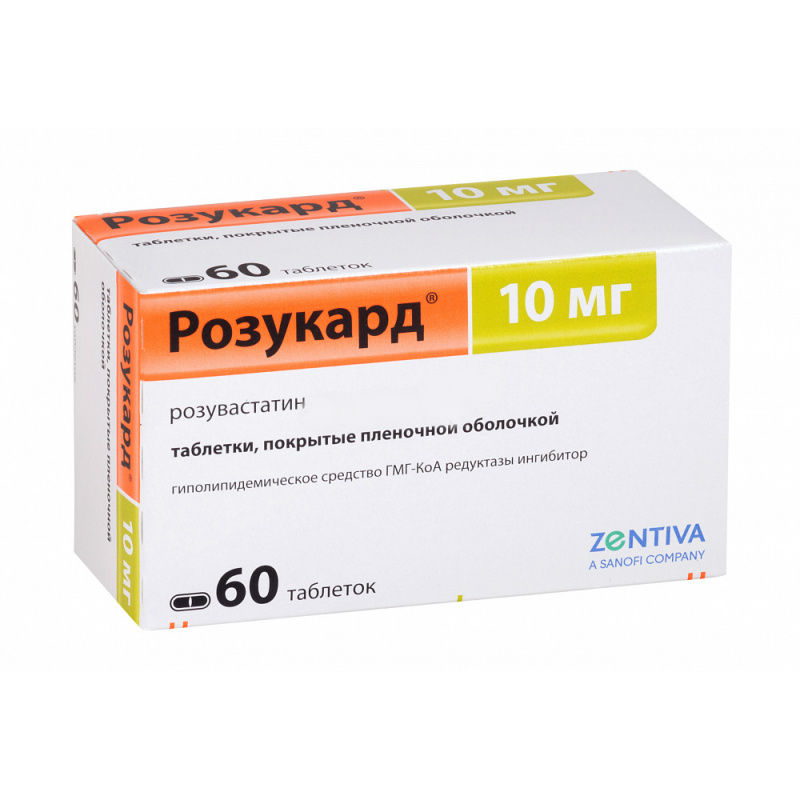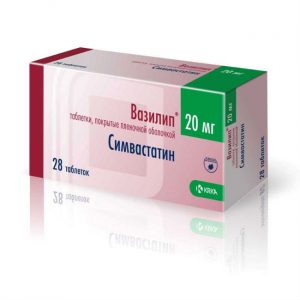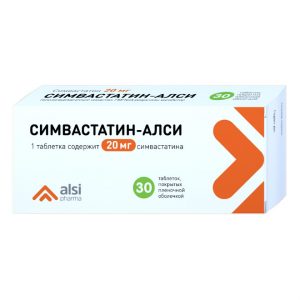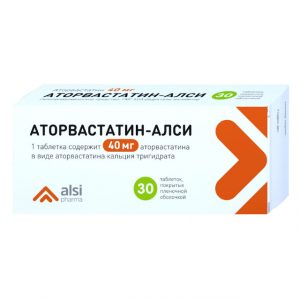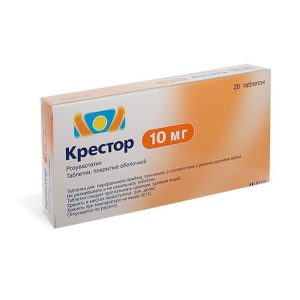Description
Release form
Film-coated tablets 10 mg, 20 mg, 40 mg.
10 tablets in a blister of A1 / A1. 3 or 9 blisters are placed in a cardboard box along with instructions for use.
Pharmacological action
Hypolipidemic drug from the statin group. Selective competitive inhibitor of 3-hydroxy-3-methylglutaryl coenzyme A (HMG-CoA) reductase, an enzyme that converts HMG-CoA to mevalonate, a precursor of cholesterol (Xc).
Increases the number of LDL receptors on the surface of hepatocytes, which leads to increased uptake and catabolism of LDL, inhibition of VLDL synthesis, reducing the overall concentration of LDL and VLDL. Decreases the concentration of LDL-C, HDL cholesterol-non-lipoproteins (HDL-non-HDL), HDL-V, total Xc, TG, TG-VLDL, apolipoprotein B (ApoV), lowers the ratio of LDL-C / Lc-HDL, total Xc / Xl HDL-C, Chs-not HDL-C / HDL-C, ApoB / apolipoprotein A-1 (ApoA-1), increases the concentrations of HDL-C and ApoA-1.
Hypolipidemic effect is directly proportional to the size of the prescribed dose. The therapeutic effect appears within 1 week after the start of therapy, after 2 weeks reaches 90% of the maximum, reaches a maximum by 4 weeks and then remains constant.
Clinical efficacy of
Effective in adult patients with hypercholesterolemia with or without hypertriglyceridemia (regardless of race, gender or age), including in patients with diabetes mellitus and familial hypercholesterolemia. In 80% of patients with type IIa and IIb hypercholesterolemia (according to the Fredrickson classification) with an average initial concentration of LDL-C of about 4.8 mmol / L, while taking the drug at a dose of 10 mg, the concentration of LDL-C reaches less than 3 mmol / L.
In patients with heterozygous familial hypercholesterolemia receiving rosuvastatin at a dose of 20-80 mg / day, there is a positive dynamics in the lipid profile.
The additive effect is observed in combination with fenofibrate in relation to the concentration of TG and with nicotinic acid in lipid lowering
Indications
– primary hypercholesterolemia (Fredrickson type IIa), including hereditary heterozygous hypercholesterolemia, or mixed dyslipidemia (type IIb according to Fredrickson) – as an addition to the diet, when diet and other non-drug therapies (physical activity and weight loss) are ineffective
– hereditary homozygous hypercholesterolemia as an adjunct to diet and other hypolipidemic therapy (for example, apheresis of LDL), or in cases where such therapy is not suitable for the
patient – to slow the progression of atherosclerosis – as an addition to the diet in patients who are shown therapy for sleep lowering the concentration of total cholesterol and cholesterol-LDL to target
levels – the prevention of cardiovascular complications in adult patients with an increased risk of cardiovascular disease due to atherosclerosis – as adjunctive therapy.
Contraindications
– liver disease in the active phase, including a persistent increase in serum transaminase activity and any increase in serum transaminase activity (more than 3 times compared with VGN)
– pronounced renal dysfunction (CC <30 ml / min) – myopathies – simultaneous administration of cyclosporine – pregnancy – lactation period – in women of reproductive age in the absence of adequate methods of contraception – predisposition to the development of myotoxic complications hereditary galactose intolerance, lactase deficiency or malabsorption syndrome of glucose and galactose – hypersensitivity to the components of the drug. For a dose of 40 mg: – moderate renal failure (CC <60 ml / min) – hypothyroidism – conditions that can lead to an increase in plasma concentration of rosuvastatin – concomitant use of fibrates – patients of the Mongoloid race of muscle disease a history of is myotoxicity with other HMG-CoA reductase inhibitors or fibrates in the history of is chronic alcoholism. Use during pregnancy and lactation Rosucard ® is contraindicated in pregnancy and lactation (breastfeeding). The use of Rosucard ® in women of reproductive age is only possible if reliable methods of contraception are used and if the patient is informed about the possible risk of treatment for the fetus. Since cholesterol and substances synthesized from cholesterol are important for fetal development, the potential risk of inhibiting HMG-CoA reductase exceeds the benefits of using the drug during pregnancy. If pregnancy is diagnosed during treatment with the drug, Rosucard should be stopped immediately, and the patient should be warned of the potential risk to the fetus. If it is necessary to use the drug during lactation, given the possibility of adverse events in infants, the issue of stopping breastfeeding should be addressed. Special instructions Effect on the kidneys Proteinuria, detected in the analysis in most cases, has a tubular nature, and was observed in patients taking higher doses of rosuvastatin, in particular 40 mg, and in most cases was transient or transient. Proteinuria is not an indicator of acute or progressive kidney disease. Serious impaired renal function is more common when taking the drug at a dose of 40 mg. The results of the study of renal function must be taken into account during the standard observation period for patients who received the drug at a dose of 40 mg. Effect on skeletal muscle Myalgia, myopathy and, in rare cases, rhabdomyolysis were observed in all patients, regardless of dose, and in particular at doses> 20 mg. Very rare cases of rhabdomyolysis have been reported with ezetimibe in combination with HMG-CoA reductase inhibitors. The pharmacodynamic interaction cannot be ruled out. Caution should be exercised with the combined use of drugs. As with other HMG-CoA reductase inhibitors, the incidence of rhabdomyolysis associated with rosuvastatin was higher at doses of 40 mg.
KFK measurement
KFK cannot be determined after intense physical activity or in the presence of another likely cause of an increase in KFK, which may interfere with the correct interpretation of the result. If the level of CPK is significantly increased before the start of treatment (> 5 VGN), then a reanalysis should be performed within 5-7 days. If a repeated analysis confirms the initial level of CPK> 5 VGN, the drug should not be prescribed.
Before treatment with
, rosuvastatin, like other HMG-CoA reductase inhibitors, should be used with caution in patients who have a predisposition to myopathy / acute skeletal muscle necrosis. These factors include:
– impaired renal function
– hypothyroidism,
– individual or hereditary muscle disorders
– muscle toxicity that has occurred in the history of the disease when taking another inhibitor of HMG-CoA reductase or
fibrates – alcohol abuse
– age> 70 years
– the likelihood of increasing the concentration of rosuvastatin in plasma
– the simultaneous administration of fibrates.
In these patients, the risk of treatment should be weighed against potential benefits, and clinical monitoring is recommended. If the initial level of CPK is significantly increased (> 5 VGN), treatment should not be started.
During treatment with
, warn patients so that they inform the doctor in case of any unexplained muscle pain, weakness or cramps, in particular, accompanied by malaise or fever. In these patients, the level of CPK should be determined. Treatment should be discontinued if CPK is significantly increased (> 5 VGN), or if muscle symptoms are severe, and cause daily discomfort (even if the level of KFK corresponds to VGN). If the symptoms disappear and the CPK value returns to normal, you can try to start treatment with rosuvastatin again or prescribe an alternative inhibitor of HMG-CoA reductase in the minimum effective dose under close medical supervision. Standard monitoring of CPK levels in patients without clinical symptoms is not justified.
In clinical studies in a small group of patients, who took rosuvastatin and received simultaneous treatment of muscle disorders, there was no increase in cases of skeletal muscle problems. However, an increase in cases of myositis and myopathy was seen in patients who took other HMG-CoA reductase inhibitors along with fibroic acid derivatives (including gemfibrozil), cyclosporine, nicotinic acid, azole antifungal drugs, protease inhibitors and macrolides. Gemfibrozil increases the risk of myopathy if taken simultaneously with some HMG-CoA reductase inhibitors. Therefore, a combination of rosuvastatin and gemfibrozil is not recommended. The ratio of the benefits of further lowering lipids and the potential risk of concomitant use of rosuvastatin with fibrates or niacin should be carefully weighed. 40 mg rosuvastatin is contraindicated while taking fibrate.
Rosuvastatin should not be prescribed to patients with acute myopathy or in serious conditions with the possibility of developing myopathy or with a predisposition to the development of renal failure, secondary rhabdomyolysis (e.g. sepsis, arterial hypotension, major surgery, trauma, serious metabolic, endocrine and electrolyte disorders, uncontrolled seizures )
Effect on the liver
Like other HMG-CoA reductase inhibitors, caution is required when taking rosuvastatin in patients who abuse alcohol and / or suffer from liver disease. Before starting treatment and after 3 months from the start, it is recommended to perform functional tests of the liver. Rosuvastatin should be discontinued, or the dose should be reduced, if the level of transaminases in serum is more than 3 times higher than VGN. Serious impaired liver function (mainly manifested by an increase in the level of transaminases in the liver) is more common when taking the drug at a dose of 40 mg.
In patients with secondary hypercholesterolemia caused by hypothyroidism or nephrotic syndrome, treatment of the underlying disease is necessary before treatment with rosuvastatin is started.
Ethnic groups
Pharmacokinetic studies show an increase in the effect of the drug on representatives of Asian nationalities compared with representatives of the European race.
Interstitial pulmonary disease
When using statins, single cases of interstitial pulmonary disease have been reported, especially when long-term therapy was performed. Symptoms may include shortness of breath, dry cough and general deterioration (fatigue, weight loss, and fever). If there is a suspicion of a patient developing interstitial lung disease, statin therapy should be discontinued.
Diabetes mellitus
In patients with fasting blood glucose of 5.6 6.9 mmol / L, treatment with rosuvastatin was associated with an increased risk of diabetes.
Effect on the ability to drive vehicles and control mechanisms
Dizziness is possible with the use of the drug. This should be considered by patients when driving vehicles or working with machinery.
Composition
Each 10 mg film-coated tablet contains: active substance: rosuvastatin – 10,000 mg (in the form of calcium rosuvastatin – 10,400 mg)
excipients: core: lactose monohydrate – 60,000 mg, microcrystalline cellulose – 45,400 mg, sodium crystalline 1,200 mg, colloidal silicon dioxide – 0,600 mg, magnesium stearate – 2,400 mg
film coat: hypromellose 2910/5 – 2,500 mg, macrogol 6,000 – 0,400 mg, titanium dioxide – 0,325 mg, talc – 0,475 mg, iron oxide red – 0,013 mg
Side effects
Often (> 1/100, <1/10): headache, dizziness, nausea, abdominal pain, constipation myalgia, asthenic syndrome, diabetes mellitus (in patients with fasting glucose levels of 5.6-6.9 mmol / l) . Infrequently (> 1/1000, <1/100): itching, rash, urticaria. Rarely (> 1/10 000, <1/1000): hypersensitivity reactions, including angioedema, myopathy, rhabdomyolysis, elevated levels of hepatic transaminases, pancreatitis. Very rare (<1/10 000): jaundice, hepatitis polyneuropathy memory loss hematuria arthralgia depression, sleep disorders sexual dysfunction. In rare cases: interstitial lung disease. Proteinuria is possible in patients receiving Rosucard ®. In most cases, proteinuria decreases or disappears during therapy and does not mean the occurrence of acute or progression of an existing kidney disease. As with other HMG-CoA reductase inhibitors, the incidence of side effects is dose-dependent. Overdose Symptoms: increased side effects of the drug. Treatment: symptomatic and supportive care. It is necessary to control liver function and CPK level. Hemodialysis is unlikely to be effective. Storage conditions The product should be stored out of the reach of children, protected from light and moisture, in the original package, at a temperature not exceeding 25 ° C. Term hodnosty 2 years active substance Rosuvastatin Pharmacy terms Prescription lekarstvennaja form tablets
